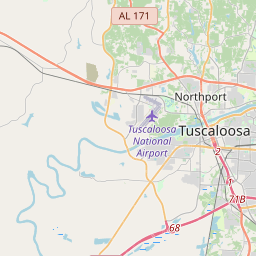Masons Marks
Historical marker location:
Tuscaloosa, Alabama
( Marker can be reached from the intersection of 6th Street and 28th Avenue.)
Marker installed: 1992







© OpenStreetMap contributors
The state of Alabama played a significant role in the Civil Rights Movement of the 1950s and 60s. The Montgomery Bus Boycott, which was sparked by Rosa Parks' refusal to give up her seat on a bus, took place in Montgomery, Alabama in 1955. The city was also the site of the Selma to Montgomery marches in 1965, which were a key event in the struggle for voting rights for African Americans.
About Tuscaloosa County
Tuscaloosa County Timeline
Tuscaloosa County, located in the state of Alabama, has a rich and diverse history that stretches back thousands of years. The area was initially inhabited by Native American tribes such as the Choctaw and Chickasaw, who relied on the fertile land for farming and hunting. The first Europeans arrived in the 16th century, with Hernando de Soto exploring the region in 1540 and establishing contact with the native tribes.
In 1816, Tuscaloosa County was officially created and named after the Native American Chief Tuskaloosa. The county became an important hub for cotton production and trade in the antebellum South, thanks to its fertile soil and proximity to major rivers. Plantations thrived, and enslaved individuals played a crucial role in the development of the region's economy.
During the Civil War, Tuscaloosa County experienced the impact of the conflict as it fell under Union control in 1865. The county faced significant challenges during the Reconstruction era, as the economy struggled to recover and racial tensions persisted. However, the county gradually rebuilt its infrastructure and saw the emergence of industries such as coal mining and timber.
In the 20th century, Tuscaloosa County entered a new era of growth and development. The expansion of the University of Alabama, founded in Tuscaloosa in 1831, brought increased population and economic opportunities. The county also became an important center for automotive manufacturing, with the establishment of factories by companies such as Mercedes-Benz and Michelin.
Today, Tuscaloosa County is a vibrant and culturally diverse region, known for its strong sense of community and bustling downtown area. Its history is celebrated through various historical sites and museums, offering visitors and residents a glimpse into the county's past while embracing the opportunities of the present.
In 1816, Tuscaloosa County was officially created and named after the Native American Chief Tuskaloosa. The county became an important hub for cotton production and trade in the antebellum South, thanks to its fertile soil and proximity to major rivers. Plantations thrived, and enslaved individuals played a crucial role in the development of the region's economy.
During the Civil War, Tuscaloosa County experienced the impact of the conflict as it fell under Union control in 1865. The county faced significant challenges during the Reconstruction era, as the economy struggled to recover and racial tensions persisted. However, the county gradually rebuilt its infrastructure and saw the emergence of industries such as coal mining and timber.
In the 20th century, Tuscaloosa County entered a new era of growth and development. The expansion of the University of Alabama, founded in Tuscaloosa in 1831, brought increased population and economic opportunities. The county also became an important center for automotive manufacturing, with the establishment of factories by companies such as Mercedes-Benz and Michelin.
Today, Tuscaloosa County is a vibrant and culturally diverse region, known for its strong sense of community and bustling downtown area. Its history is celebrated through various historical sites and museums, offering visitors and residents a glimpse into the county's past while embracing the opportunities of the present.
Tuscaloosa County Timeline
This timeline provides a concise overview of the key events in the history of Tuscaloosa County, Alabama.
- Early 1800s: Native American tribes, including the Choctaw and Creek, inhabit the area that is now Tuscaloosa County.
- 1813: Andrew Jackson leads the American forces in the Battle of Talladega against the Creek Nation near present-day Tuscaloosa County.
- 1817: Tuscaloosa County is established by the Alabama Territorial Legislature.
- 1826: Tuscaloosa becomes the state capital of Alabama.
- 1831: The University of Alabama is founded in Tuscaloosa.
- April 27, 2011: A devastating EF4 tornado strikes Tuscaloosa County and the city of Tuscaloosa, causing significant damage and loss of life.
- Present: Tuscaloosa County is a vibrant community with a diverse economy, thriving education institutions, and rich cultural heritage.